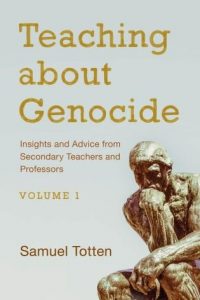 Teaching about Genocide (Volume I), the first of a two-volume series edited by well-known Holocaust and genocide education scholar Samuel Totten, provides cogent, practical advice for those wishing to bring this difficult topic into their classrooms. The book builds on Totten’s previous work but is unique in its specific focus on combining insights from both secondary and post-secondary educators in each volume. Roughly half of the chapters were written by secondary educators, with the remaining composed by post-secondary professors and instructors. This combination helps to bridge the persistent gap between academic genocide studies research and secondary classroom teaching about genocide. Indeed, as a high school teacher of a semester-long comparative genocide studies course, I have often struggled to find ways to approach various aspects of genocide with my students. This volume both reaffirms the importance of genocide education while providing practical support for classroom teachers.
Teaching about Genocide (Volume I), the first of a two-volume series edited by well-known Holocaust and genocide education scholar Samuel Totten, provides cogent, practical advice for those wishing to bring this difficult topic into their classrooms. The book builds on Totten’s previous work but is unique in its specific focus on combining insights from both secondary and post-secondary educators in each volume. Roughly half of the chapters were written by secondary educators, with the remaining composed by post-secondary professors and instructors. This combination helps to bridge the persistent gap between academic genocide studies research and secondary classroom teaching about genocide. Indeed, as a high school teacher of a semester-long comparative genocide studies course, I have often struggled to find ways to approach various aspects of genocide with my students. This volume both reaffirms the importance of genocide education while providing practical support for classroom teachers.
The necessity for such a work at this moment is clear. While the Holocaust, especially since the mid-1990s, has become a mainstay of American K-12 school curriculum, teaching about so-called “other” genocides or “genocides other than the Holocaust,” has become increasingly common across the country. Though, despite this trend, few resources exist for educators, who, are often left to teach such difficult topics with little content or pedagogical support.
Henry Friedlander, quoted in the introduction, writes: “The problem with too much being taught by too many without focus is that this poses the danger of destroying the subject matter through dilettantism. It is not enough for well-meaning teachers to feel a commitment to teach about [genocide] they also must know the subject.” This is particularly true of secondary educators who must be masters of, and adept at teaching, a huge breadth of content. Teaching about Genocide gives voice to those educators who have struggled to develop ways to teach about genocide in their classrooms to inspire their fellow educators.
The 22 chapters in the work are divided into two sections: “Insights and Advice from Secondary Level Teachers” and “Insights and Advice from College and University Professors.” Both sections begin with chapters providing general overviews and rationale for teaching about genocide before progressing to more-specific case studies. Minnesota high school teacher, and long-time collaborator with the CHGS, Nancy Ziemer’s, “Advice on Teaching About Genocide,” provides an overview and suggestions pulled from her 25 years of experience teaching about genocide, while my contribution, “Why Don’t We Talk About Rape?” offers rationale drawn from my classroom experience for teaching about sexualized violence in genocide. While the chapters don’t provide specific, structured lesson plans, authors pair descriptions of classroom experiences with resources, such as Gregory Stanton’s 10 Stages of Genocide, providing inspiration for teachers to create their own lessons suitable for their students and contexts. In short, both beginning and experienced teachers alike will find this book useful in their classroom practice.
The latter half of the book, devoted to advice from professors and university instructors, provides chapters from well know genocide scholars, such as Israel Charney, Ernesto Verdeja, and Kjell Anderson. Drawn from a number of academic fields and research/teaching contexts, these chapters extend and supplement earlier chapters, providing advice and insights that are equally appropriate and useful for secondary contexts. Indeed, Kimberley Ducey’s “Survivors of Sexual Violence in Rwanda Speak: A Letter-Writing Assignment to Combat Psychic Numbing” provides a lesson idea and classroom anecdotes that pairs with my chapter on teaching about sexual violence. This and many other chapters have already informed my own planning and found their way into my teaching. The book closes with an annotated bibliography, pulling together additional genocide education resources.
While the book’s focus on curricular and pedagogical insights for secondary and post-secondary educators seems a logical choice, as, in many cases, there is little intellectual or emotional divide between upper-level high school and college-level students, this work fails to address the growing need for resources at the elementary and middle school levels. While Totten and other scholars have written persuasively against teaching about the Holocaust and genocide to students in the elementary, A growing number of middle school students encounter such content each year, with states like New Jersey requiring Holocaust and genocide education for students in grades 5-8. Many of my colleagues have voiced the need for similar work addressing the specific pedagogical demands of teaching younger students.
Teaching about Genocide (Volume II) was also published in late 2018. The decision to publish a second volume in the series, thereby reducing the cost of both volumes, makes this an affordable book for educators.
George D. Dalbo is a Ph.D. student in Social Studies Education at the University of Minnesota with research interests in Holocaust, comparative genocide, and human rights education in secondary schools. Previously, he was a middle and high school social studies teacher, having taught every grade from 5th-12th in public, charter, and independent schools in Minnesota, as well as two years at an international school in Vienna, Austria.

Comments